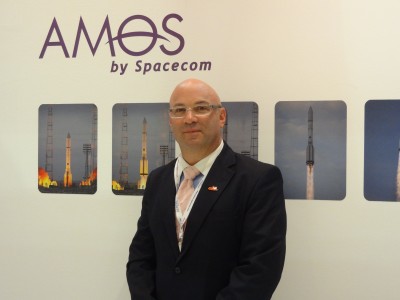
Eyal Copitt, SVP Sales Africa, Asia & Marketing, Spacecom
Q: How is Amos entering the Asia-Pacific market?
A: First of all, Amos Spacecom is a satellite operator since 1996. In the beginning, we started with Europe, Middle East and Africa. This year, we are going to launch a satellite in a new orbital location of 65 degrees East, AMOS-4 – which for us is a totally new business, penetrating into the Asian market.
Having the satellite at 65 degrees East over the Indian Ocean allows us to serve from Russia and China in the north to Southeast Asia and Southern Africa. We are allocating three beams to Asia – the Russian beam (Russia), the Ka beam (China) and the Southeast Asian beam (Malaysia and Indonesia, including Philippines – depending on the needs).
We started up in Asia about nine months ago. We’re recruiting agents in all of the countries into sales people handling the region. This is also the first year we are exhibiting in a booth of our own – nice, shiny and in bold colours. For the past two years, we exhibited under the Israeli Pavilion. For this year, we’re both under the Israeli Pavilion as well as on our own.
Q: There are many satellite operators in Asia. Are you concern about market saturation and which specific territories are you focusing on in Asia?
A: I don’t think it’s saturated. I think that the new technologies and the new requirements coming from users are increasing the demand. If we go to broadband, and at the beginning, a small or narrow link at home was enough, today you would want more. You’ll want to see more content. Even the governments are starting to move their services to e-service. You don’t need to go to the office to make the arrangements that you need. You can do it over the web. More people will have to be connected and more bandwidth will be required.
Satellite, I find, is the fastest way to execute because you don’t need an infrastructure. You can get it everywhere in no amount of time. Also, we have the broadcast world. A few years ago, we had very few channels and today, we have endless channels. We have HD, Ultra HD, 3D and etc, and we want more and more. I believe that this will always require more and more bandwidth. Hence, I don’t think that it will be saturated so fast.
When we are looking at covering an area, you ask if we prefer an area over others. It’s not about what we prefer. Firstly, having a satellite positioned at 65 degrees East, not all of the areas will be covered in the same way. Some areas will have lower looking angles and in others, higher looking angles. We try to serve with the best service. Second of all, we look at where the demand is currently. Satellites are up there in the air and burning fuel already so we don’t have the legacy of waiting so we’re tapping on all of the territories, trying and checking all of the places to see where the demand is and where we can give a good service.
We are a relatively small and young company when compared to others. We focus on being flexible and customer-oriented. We’re trying to tailor the solutions that they need and be as close to the customer – from the CEO, to the sales, operations and customer service. I think that this is what gives us the edge over others – in the sense that we’re being close to the customers, understanding and trying to provide better service.
Q: What services are you looking to provide here for broadcasters and operators?
A: Our satellites are very unique satellites, in which it could uplink from any beam and downlink from other beam. You can have crossbeams between KU-1 to KU-2 to the Ka beam. If I put one beam here (in Singapore) and one in Russia, you can uplink here and downlink in Russia, or China. It’s a flexible range of services for broadcasting. Also, we have an air station in Israel which can cover Asia in one hand and Europe and the U.S in the other. We can use our base station in Israel as a hub to connect Asia to the West and vice-versa.
Basically, as a company, we deliver the capacity. We can support our customers by being in their uplinks and whatever is required. We are more focused on selling the capacity to support our customers technically to execute their own business.
Q: Do you offer playout services?
A: No, we don’t but we have a sister company called SatLink – which is based near Jerusalem. They are providing those services.
Q: Is that a service you hope to provide here for Asian clients as well?
A: In this case, it’s our sister company but we are open to anyone our customers choose. We know how to work with everyone, everywhere and we don’t tie them down to a service. We are independent.
Q: What kind of conversations are you having with some of the broadcasters here in Asia?
A: Well, we met almost every significant player in the region, starting with telcos, to broadcasters, and then moving to ISP providers who are providing governmental broadband services to schools in rural areas. We are discussing with everyone. They’re taking into consideration that the satellites are almost full but there will be more satellites to come afterwards to Asia.
We are now starting our way into Asia. It’s important for us to know and be known by everyone. We’re here to see and be seen, as well as, to create a relationship to fill our future satellites in the region.
Q: Could you provide us with some information on the AMOS-4 satellite launch?
A: The launch should be during the first week of September, hopefully with no delays. We’re using the Kazakhstan launch site (Space International Services).










